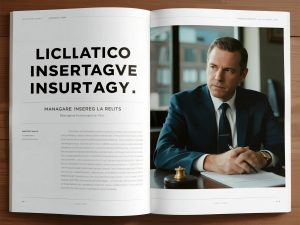Comprehensive Umbrella Insurance Protection for Modern Corporate Liability Management The strategic implementation of umbrella insurance for companies represents an essential component of contemporary corporate risk management frameworks, providing critical excess liability protection that extends beyond the coverage limits of primary insurance policies to safeguard organizational assets, financial stability, and business continuity objectives. These sophisticated insurance solutions address the substantial liability exposures that
modern businesses face in increasingly complex legal environments and litigious landscapes, ensuring comprehensive financial protection against catastrophic loss scenarios, substantial legal judgments, and significant settlement amounts that could otherwise threaten corporate viability and shareholder value. Corporations across various industry sectors benefit from umbrella insurance coverage specifically designed to complement their existing liability protection layers, with policy terms that understand the intricate liability landscape, regulatory environment characteristics, and financial exposure parameters that influence appropriate excess coverage levels and protection structures for comprehensive corporate risk management. The fundamental importance of corporate umbrella insurance lies in its ability to provide additional liability protection layers, preserve corporate assets against substantial claims, and maintain financial stability when facing liability scenarios that exceed primary insurance limits, helping organizations manage their liability risks effectively while protecting against catastrophic financial consequences from large loss events that could compromise business operations and strategic objectives.The effective implementation of umbrella insurance for companies involves careful assessment of organizational liability exposures, evaluation of primary insurance coverage limits, and analysis of financial protection needs that collectively determine appropriate umbrella coverage amounts, policy attachment points, and protection terms for comprehensive corporate liability management programs. These insurance solutions typically feature broad coverage extensions addressing various liability exposures across different operational areas, business activities, and geographic locations that might not be adequately covered through primary insurance approaches or may require coordinated excess protection strategies to ensure complete risk transfer. The specialized coverage integration addresses corporate-specific liability
concerns such as product liability exposures, premises liability risks, completed operations hazards, and contractual liability obligations that require tailored protection strategies based on particular business models, industry characteristics, and operational complexities. The claims management expertise ensures that when substantial liability events occur, policyholders receive appropriate support from specialized claims professionals who understand the business implications, financial consequences, and operational challenges associated with large liability claims affecting organizational performance and strategic direction. The risk assessment services include guidance on liability exposure analysis, insurance program design, coverage coordination strategies, and risk mitigation practices that help organizations reduce their liability risks through proactive risk management and comprehensive insurance protection approaches. The premium calculation methodologies reflect the specialized nature of umbrella coverage, with pricing considerations including industry sector characteristics, historical loss experience, revenue levels, and risk management practices that influence appropriate premium levels for comprehensive excess liability protection. The continuous program evaluation ensures that umbrella insurance coverage remains aligned with evolving business operations, regulatory requirements, and liability environments that affect corporate risk exposures and appropriate protection needs over time. The comprehensive financial protection provided by strategic umbrella insurance solutions allows organizations to manage their liability risks effectively, maintain business continuity during challenging periods, and protect corporate value against the substantial financial consequences of catastrophic liability events that could otherwise threaten organizational stability and long-term success in competitive market environments.Strategic Corporate Liability Insurance Protection for American Businesses
Comprehensive corporate liability insurance USA solutions provide essential financial protection for organizations operating within the complex American legal environment, addressing the substantial liability exposures that businesses face from various sources including third-party bodily injury claims, property damage allegations, personal injury lawsuits, and advertising injury disputes that could result in significant financial losses and operational disruptions. These sophisticated insurance programs understand the unique liability landscape that American corporations navigate, with policy terms designed to address specific regulatory requirements, legal precedents, and jurisdictional variations that influence liability exposure management across different states and federal jurisdictions. Businesses benefit from corporate liability insurance coverage specifically tailored to their operational characteristics, industry sector risks, and organizational size parameters, ensuring appropriate protection against the financial consequences of liability claims that could arise from normal business activities, product distribution channels, service delivery processes, and operational practices. The fundamental advantage of corporate liability insurance lies in its ability to transfer substantial financial risks from the organization to insurance carriers, allowing companies to focus on core business objectives while maintaining financial protection against liability scenarios that could otherwise consume corporate resources, damage business reputation, and compromise competitive positioning in dynamic market conditions.
The strategic implementation of corporate liability insurance USA involves careful evaluation of organizational risk profiles, assessment of liability exposure sources, and analysis of coverage requirements that collectively determine appropriate insurance limits, policy terms, and protection structures for comprehensive liability risk management. These insurance solutions typically feature multiple coverage components addressing general liability protection, products-completed operations coverage, contractual liability obligations, and personal advertising injury protection that standard business policies may not adequately address or may limit through specific exclusions and coverage restrictions. The specialized coverage approaches address industry-specific liability concerns such as professional service exposures, manufacturing defect risks, construction defect liabilities, and environmental impairment obligations that require customized insurance solutions based on particular business operations and risk characteristics. The underwriting process for corporate liability insurance involves detailed assessment of organizational operations, risk management practices, loss history records, and financial stability factors that influence both coverage availability and premium calculations within the commercial insurance marketplace. The claims handling expertise ensures that when liability events occur, policyholders receive appropriate support from insurance professionals who understand the legal complexities, financial implications, and business consequences associated with liability claims affecting organizational performance and stakeholder relationships. The risk management services offered by corporate liability insurance providers include access to legal counsel, safety engineering resources, and loss control specialists who help organizations prevent liability scenarios, respond effectively when they occur, and implement corrective measures following liability events. The premium structures for corporate liability coverage reflect the risk-based nature of protection, with pricing considerations including industry classification factors, revenue levels, claims experience, and risk control measures that collectively determine appropriate premium levels for comprehensive liability protection. The continuous coverage management ensures that corporate liability insurance remains aligned with evolving business operations, regulatory changes, and legal developments that affect liability exposure profiles and appropriate protection needs over time. The financial security provided by comprehensive corporate liability insurance allows businesses to operate with confidence, pursue growth opportunities, and manage their liability risks effectively while protecting against the substantial financial consequences of liability claims that could otherwise threaten organizational stability and long-term success in the competitive American business environment.
Essential Corporate Crime Insurance Protection for Financial Security
Specialized corporate crime insurance solutions provide critical financial protection for organizations facing potential losses resulting from fraudulent activities, dishonest employee actions, computer fraud schemes, funds transfer fraud incidents, and other criminal activities that could compromise corporate assets, financial integrity, and business operations. These sophisticated insurance products address the substantial financial risks associated with white-collar crime, employee dishonesty, and third-party criminal activities that modern businesses encounter in increasingly digital and complex operational environments, ensuring comprehensive protection against financial losses, asset misappropriation, and fraudulent transactions that could otherwise threaten organizational viability and stakeholder confidence. Corporations benefit from crime insurance coverage specifically designed to address their unique vulnerability profiles, with policy terms that understand the evolving nature of corporate crime, technological advancement impacts, and internal control challenges that influence appropriate coverage structures and protection limits for comprehensive financial crime risk management. The fundamental importance of corporate crime insurance lies in its ability to provide financial reimbursement for stolen assets, cover investigation costs, and support recovery efforts following criminal activities, helping organizations maintain financial stability, protect stakeholder interests, and preserve business reputation while addressing the challenges associated with corporate crime prevention and response strategies.
The effective implementation of corporate crime insurance involves careful assessment of organizational crime exposures, evaluation of internal control effectiveness, and analysis of financial protection needs that collectively determine appropriate coverage limits, policy terms, and protection structures for comprehensive corporate crime risk management programs. These insurance solutions typically feature multiple coverage components addressing employee dishonesty losses, computer fraud incidents, funds transfer fraud scenarios, forgery alterations, and money transfer deception schemes that standard commercial insurance policies may not adequately cover or may explicitly exclude from protection scope. The specialized coverage enhancements address industry-specific crime concerns such as financial institution embezzlement risks, healthcare billing fraud exposures, retail inventory theft scenarios, and manufacturing asset misappropriation challenges that require tailored insurance approaches based on particular business models and operational characteristics. The risk assessment process for corporate crime insurance involves detailed evaluation of internal control environments, employee screening practices, financial transaction procedures, and information security measures that influence both coverage availability and premium calculations within the crime insurance marketplace. The claims investigation expertise ensures that when criminal activities occur, policyholders receive appropriate support from specialized forensic accountants, fraud investigators, and legal professionals who understand the financial complexities, evidentiary requirements, and recovery challenges associated with corporate crime incidents affecting organizational assets and financial integrity. The loss prevention services include guidance on internal control development, employee education programs, fraud detection systems, and security enhancement measures that help organizations reduce their crime risks through proactive risk management and comprehensive protection strategies. The premium calculation methodologies reflect the risk-based nature of crime coverage, with pricing considerations including industry sector characteristics, revenue levels, internal control effectiveness, and historical loss experience that influence appropriate premium levels for comprehensive crime protection. The continuous program management ensures that corporate crime insurance remains aligned with evolving criminal tactics, technological advancements, and regulatory requirements that affect corporate crime exposures and appropriate protection needs over time. The financial protection provided by strategic corporate crime insurance solutions allows organizations to manage their crime risks effectively, maintain operational integrity during investigation periods, and protect corporate assets against the substantial financial consequences of criminal activities that could otherwise compromise organizational stability and business continuity in challenging circumstances.

Comprehensive Director and Officer Insurance Protection for Corporate Leadership
Essential director & officer insurance coverage provides critical financial protection for corporate leaders facing potential personal liability arising from their management decisions, oversight responsibilities, and governance activities that could result in legal actions, regulatory investigations, and financial claims against their personal assets. These sophisticated insurance solutions address the substantial liability exposures that directors and officers encounter in their corporate roles, ensuring comprehensive protection against allegations of wrongful acts, management errors, breach of fiduciary duties, and governance failures that could otherwise threaten personal financial security and professional reputation. Corporate leaders benefit from director and officer insurance coverage specifically designed to address their unique liability exposures, with policy terms that understand the complex legal environment, regulatory requirements, and shareholder expectations that influence appropriate protection levels and coverage structures for comprehensive leadership risk management. The fundamental importance of director and officer insurance lies in its ability to provide defense cost coverage, settlement payment protection, and judgment reimbursement for personal liability claims, helping corporate leaders fulfill their governance responsibilities without excessive concern about personal financial exposure from management decisions and oversight activities conducted in good faith.
The strategic implementation of director & officer insurance involves careful assessment of corporate governance structures, evaluation of leadership liability exposures, and analysis of protection needs that collectively determine appropriate coverage limits, policy terms, and protection structures for comprehensive director and officer risk management programs. These insurance solutions typically feature multiple coverage components addressing entity protection, side A coverage for non-indemnifiable losses, side B coverage for corporate reimbursement, and side C coverage for securities claims that standard commercial insurance policies may not adequately address or may specifically exclude from protection scope. The specialized coverage enhancements address industry-specific director and officer concerns such as financial institution regulatory exposures, healthcare compliance challenges, technology company intellectual property risks, and manufacturing safety obligations that require tailored insurance approaches based on particular corporate characteristics and industry sector requirements. The underwriting process for director and officer insurance involves detailed evaluation of corporate governance practices, financial reporting procedures, risk management frameworks, and historical litigation experience that influence both coverage availability and premium calculations within the management liability insurance marketplace. The claims management expertise ensures that when director and officer claims occur, policyholders receive appropriate support from specialized legal counsel, claims professionals, and crisis management experts who understand the governance implications, regulatory complexities, and personal consequences associated with leadership liability claims affecting corporate reputation and individual professional standing. The risk management services include guidance on corporate governance best practices, board education programs, compliance framework development, and disclosure procedure enhancement that help organizations reduce their director and officer liability risks through proactive governance improvement and comprehensive protection strategies. The premium structures reflect the risk-based nature of director and officer coverage, with pricing considerations including industry classification factors, corporate size parameters, financial performance metrics, and governance practice quality that collectively determine appropriate premium levels for comprehensive leadership protection. The continuous program evaluation ensures that director and officer insurance remains aligned with evolving regulatory requirements, legal precedents, and governance expectations that affect leadership liability exposures and appropriate protection needs over time. The financial security provided by strategic director and officer insurance solutions allows corporate leaders to focus on strategic decision-making, exercise business judgment with confidence, and fulfill their governance responsibilities without excessive concern about personal financial exposure from management activities conducted in the best interests of the organization and its stakeholders.
Professional Errors and Omissions Insurance Protection for Service Excellence
Comprehensive E&O insurance USA solutions provide essential financial protection for service providers, professional firms, and consulting organizations facing potential liability claims arising from alleged errors, omissions, negligence, or inadequate performance in their professional services delivery, advice provision, or work product quality. These sophisticated insurance products address the substantial liability exposures that professional service providers encounter in their client engagements, ensuring protection against financial losses, damages awards, and defense costs resulting from professional negligence claims, service delivery failures, and advice quality disputes that could otherwise threaten business viability and professional reputation. American service organizations benefit from errors and omissions insurance coverage specifically designed to address their unique professional liability risks, with policy terms that understand the specific service standards, industry practices, and client expectations that influence appropriate protection levels and coverage structures for comprehensive professional risk management. The fundamental advantage of errors and omissions insurance lies in its ability to provide defense cost coverage, settlement payment protection, and damages reimbursement for professional liability claims, helping service providers maintain client relationships, protect business reputation, and manage professional risks effectively while focusing on service excellence and quality delivery.
The strategic implementation of E&O insurance USA involves careful assessment of professional service exposures, evaluation of client engagement characteristics, and analysis of protection needs that collectively determine appropriate coverage limits, policy terms, and protection structures for comprehensive professional liability management programs. These insurance solutions typically feature specialized coverage components addressing professional negligence claims, breach of contract allegations, misrepresentation disputes, and failure to perform obligations that standard commercial general liability policies may not adequately cover or may explicitly exclude from protection scope. The specialized coverage approaches address industry-specific professional concerns such as technology consulting errors, financial advisory mistakes, architectural design deficiencies, engineering calculation errors, and legal service omissions that require tailored insurance solutions based on particular professional disciplines and service delivery models. The underwriting process for errors and omissions insurance involves detailed evaluation of professional qualifications, service delivery methodologies, quality control procedures, and claims history records that influence both coverage availability and premium calculations within the professional liability insurance marketplace. The claims handling expertise ensures that when professional liability claims occur, policyholders receive appropriate support from specialized legal professionals, expert witnesses, and claims consultants who understand the technical complexities, professional standards, and client relationship implications associated with errors and omissions claims affecting service quality and business reputation. The risk management services include guidance on service agreement development, client communication protocols, documentation practices, and quality assurance frameworks that help professional service providers reduce their errors and omissions risks through proactive service management and comprehensive protection strategies. The premium calculation methodologies reflect the risk-based nature of professional liability coverage, with pricing considerations including professional discipline characteristics, revenue levels, claims experience history, and risk control measures that collectively determine appropriate premium levels for comprehensive errors and omissions protection. The continuous program management ensures that errors and omissions insurance remains aligned with evolving professional standards, regulatory requirements, and client expectations that affect professional liability exposures and appropriate protection needs over time. The financial protection provided by strategic errors and omissions insurance solutions allows professional service providers to deliver high-quality services, maintain client confidence, and manage their professional risks effectively while protecting against the substantial financial consequences of professional liability claims that could otherwise compromise business stability and long-term success in competitive service markets.
Integrated Corporate Insurance Strategy for Comprehensive Risk Management
The development of strategic integrated corporate insurance programs represents the culmination of comprehensive risk management planning, combining umbrella insurance for companies with specialized coverage components including corporate liability insurance USA, corporate crime insurance, director & officer insurance, and E&O insurance USA to create holistic protection frameworks that address the complete spectrum of risks facing modern organizations. These sophisticated insurance architectures understand that corporate risk management requires coordinated protection strategies across multiple coverage dimensions, ensuring seamless risk transfer, appropriate coverage limits, and comprehensive financial protection against various loss scenarios that could threaten organizational assets, financial stability, and business continuity objectives. Corporations benefit from integrated insurance approaches that provide coordinated coverage terms, consistent policy conditions, and aligned protection structures across different insurance components, creating efficient risk management frameworks that address both traditional and emerging risks through appropriate insurance product combinations and coverage coordination strategies.
The implementation of effective integrated corporate risk management involves careful coordination between different insurance components, assessment of coverage overlaps and gaps, and evaluation of program efficiency factors that collectively determine appropriate integration strategies, policy coordination approaches, and coverage optimization techniques for comprehensive corporate protection programs. These integrated frameworks typically feature coordinated policy terms, aligned coverage structures, and consistent protection approaches that address corporate risk management needs through appropriate insurance product combinations and coverage coordination strategies across different risk exposure categories and business operation areas. The specialized integration services address corporate-specific risk management concerns such as coverage coordination, policy administration, claims handling consistency, and program management efficiency that require expert guidance and professional support to ensure comprehensive protection implementation and appropriate risk management outcomes. The program management expertise ensures that integrated corporate protection frameworks maintain appropriate coordination between different insurance components, with consistent underwriting approaches, coordinated premium structures, and aligned claims handling procedures that facilitate comprehensive risk management and efficient program administration. The risk assessment coordination includes guidance on corporate risk identification, exposure quantification, protection prioritization, and program design optimization that help organizations develop comprehensive risk management strategies through appropriate insurance product selection and coverage structure configuration. The premium optimization considerations reflect the integrated nature of corporate protection, with pricing structures that account for coverage combinations, risk management benefits, and program efficiency factors that influence appropriate premium levels for comprehensive corporate insurance programs. The continuous program evaluation ensures that integrated corporate protection remains aligned with evolving business operations, regulatory requirements, risk environments, and insurance market conditions that affect corporate risk exposures and appropriate coverage approaches over time. The comprehensive protection provided by strategic integrated corporate risk management frameworks allows organizations to maintain operational stability, protect business value, ensure financial security, and manage various risk exposures effectively through coordinated insurance strategies that address the complex challenges associated with corporate risk management and business continuity planning in dynamic business environments and competitive market conditions.




